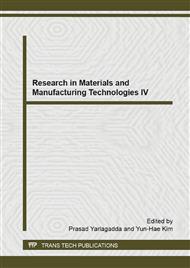[1]
Fu Gaosheng, Kang Jixing, Chen Wenzhe, Qian Kuangwu. Interactive mechanism between inclusions and hydrogen in molten aluminum [J]. The Chinese Journal of Nonferrous Metals, 1999, 95(1): 51-56. (in Chinese).
Google Scholar
[2]
D. Shu, B.D. Sun, J. Wang, T.X. Li, Z.M. Xu, and Y.H. Zhou: Metall. Mater. Trans. B, 2000, vol. 31B, p.1527–33.
Google Scholar
[3]
K. Li, J. Wang, D. Shu, T.X. Li, B.D. Sun, and Y.H. Zhou: Mater. Lett., 2002, vol. 56, p.215–20.
Google Scholar
[4]
X.S. Zheng, Z. X. Li, Y.C. Wang: Sci. Technol. Adv. Mater, 2001, vol. 2, p.113–116.
Google Scholar
[5]
Z.M. Xu, T.X. Li, and Y.H. Zhou. Metall. Mater. Trans. A, 2007, vol. 38A, p.1104–10.
Google Scholar
[6]
Kolin. A: Science, 1953, vol. 117, p.134~37.
Google Scholar
[7]
D. Shu, B.D. Sun, K. Li, T.X. Li, Z.M. Xu, and Y.H. Zhou: Mater. Lett ., 2002, vol. 55, p.322–26.
Google Scholar
[8]
Park. J. P, Tananka. Y, Sassa. K and Asai. S: ISIJ International, 1994, pp.497-504.
Google Scholar
[9]
Y. Tanaka, K. Sassa, K. Iwai, and S. Asai: Tetsu-to-Hagane´, 1995, vol. 81, p.1120–25.
Google Scholar
[10]
Miki. Y, Kitaoka. H, Safuraya. T, Fujii. T, ISIJ International. 1992, vol. 32, p.142~49.
Google Scholar
[11]
Lu. D. H, Jiang.Y. H, Guan.G. S et al. Jounral of Materials Processing Technology [J]. 2007, 189(1-3) : 13.
Google Scholar
[12]
Y.J. He, Q.L. Li, W. Liu: Mater . Lett, 2011, vol. 65, p.1226–28.
Google Scholar
[13]
Y.J. He, Q.L. Li, W. Liu: Metall. Mater. Trans. B, 2012, vol. 43, p.1149–55.
Google Scholar
[14]
Minrui Gao, Qiulin Li, Dingguo Yang, Wei Liu. An investigation on the effect of alternating rotating magnetic field on the removal of inclusions from aluminum melt.
Google Scholar
[15]
Y.C. Han, Q.L. Li, W. Liu and Y.J. He : Metall. Mater. Trans. A, 2012, vol. 43, pp.1400-04.
Google Scholar
[16]
P.G. Saffman, J.S. Turner: J. Fluid Mech., 1956, vol. 1, p.16–30.
Google Scholar
[17]
Leenov. D, Kolin. A: J. Chem. Phys. 1954, vol. 22, p.683~88.
Google Scholar
[18]
Grants I, Gerbeth G. J Cryst Growth 2004; 269: 630-8.
Google Scholar


